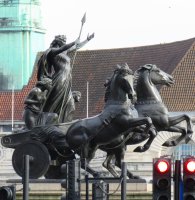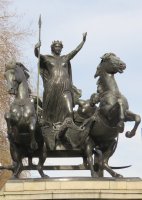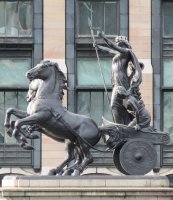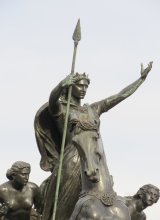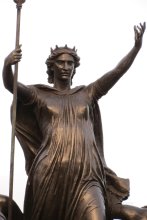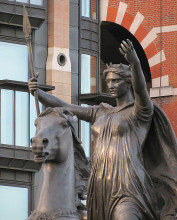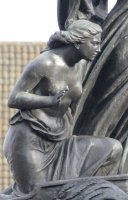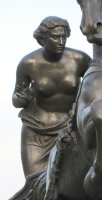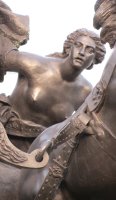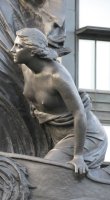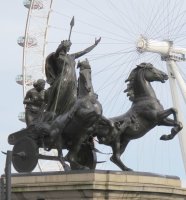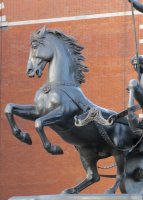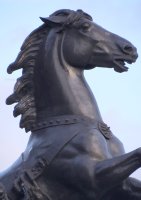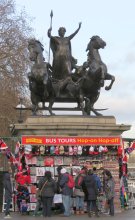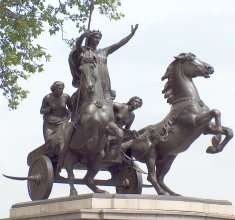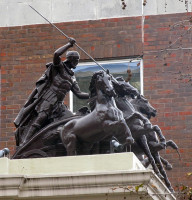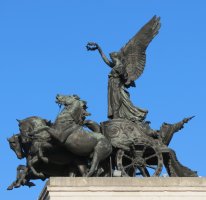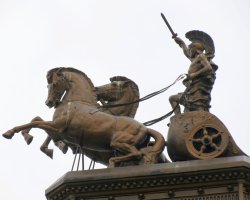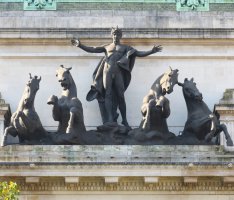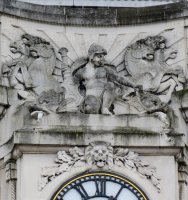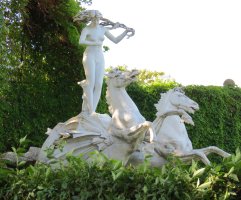Boadicea, by Westminster Bridge and Parliament
One of the most iconic of London sculptures, the Boadicea group (Boudicca to some) has the ancient British warrior queen standing in her light chariot, pulled by two rearing horses, and accompanied by two kneeling girls who are perhaps her daughters. Placed by the crossing onto Westminster Bridge from Parliament Square and the Houses of Parliament, many thousands of tourists pass by this sculpture every day, as well as the large numbers of commuters crossing the bridge and emerging from Westminster underground station.
Boadicea statue, by Thomas Thornycroft.
The statue of Queen Boadicea stands upright, back arched, arms forward and upward, urging her unseen army to charge into battle. One hand holds her spear, a thrusting rather than throwing weapon, the other is empty. She is shown as a figure in the prime of life, with youthful face and body beneath thin fabric swirling backwards to emphasise the movement, hair long under her crown, cloak over her shoulders and well away from her back. Her drapes are light enough to show the body underneath, muscular of hip and leg and stomach, somewhat less so in neck and shoulder and arm though still athletic.
Different aspects of Boadicea's two attendants or daughters.
Her two crouching attendants, who according to history may be her daughters, are shown as youthful maidens, bare breasted and wearing long skirts, the tops of which are twisted over to form a sort of belt, perhaps a pulled-down upper garment. Their heads are bare, their hair long, and they carry no weapons, each having one hand clasping around the legs and cloak of Boadicea. Like the Queen, they have a certain solidity without excessive musculature; no one could mistake them for Classical girls, even without seeing their 19th Century faces. Both lean forward, adding to the feel of dynamic motion of the whole ensemble.
Views of the horses.
The rearing horses are excellent of their type, though the sculptor has allowed himself some artistic licence in putting these thoroughbred stallions on a Celtic chariot: surely Boadicea s horses would have been pony-like animals of rather smaller size and less noble mien. [If you like horse statues, several are shown from all sides on this page and on this page.] The chariot is light, built for speed, and probably because if those horses had been of the right size, they would have struggled to pull a heavier chariot. The shaft is decorated, including a sunburst at the base, not so visible, and there are smaller sunbursts on the chests of the horses, but the most notable feature is the out-thrust, wickedly curved long knives protruding from the solid wheels, designed to cut down enemy warriors in the charge.
The horses are angled slightly outwards, and the group as a whole is symmetrical in the broad poses of both horses and figures, but with variety in the details of pose and position of limbs. The group is carefully constructed so that it looks dramatic from almost any angle, and from closer up, gives fine silhouettes against the sky. Oddly enough, from directly in front at a suitable distance, it is not possible to see all three figures (picture above left), and to do this the viewer must be slightly at an angle (above right).
The sculptor was Thomas Thornycroft, father of the more well-known William Hamo Thornycroft. He started on the group in the 1850s, exhibiting a head of Boadicea in the mid 1860s, but the full sized bronze was only erected here in 1902, the gift of another one of his sons, some years after the sculptor's death in 1885. Among his other works should be noted his equestrian statues of Queen Victoria and Prince Albert in Liverpool.
Chariot sculpture in London
Other London chariot sculpture: Chelsea and Quadriga in Hyde Park/cite>.
Sculptures of chariots are rare. The Westminster Bridge sculpture is one of two iconic chariot groups in London, the other being that by the sculptor Adrian Jones atop Constitution Arch at Hyde Park Corner, an incredibly massive bronze of Peace in her Quadriga, with four horses. On a much smaller scale and not particularly well known at all, we may note a light-hearted group on the King's Road, in Chelsea, with four horses.
The Hippodrome two-horse chariot.
Then there is another two-horse chariot, not so well known but actually rather familiar as part of the view, which is the one on top of the Hippodrome on Charing Cross Road, a cheerful, decorative work with a Classical warrior with Corinthian helmet and upraised sword. See picture above, click to enlarge.
More chariots: Australia House and Trafalgar Square.
We can add, just, the group of four horses and Apollo, or Helios (Chariot of the Sun) on Australia House in the Strand - only the fronts of the horses are sculpted, and the chariot is surmised, not actually visible. Bertram Mackennal was the sculptor.
And then another not-really chariot, just off Piccadilly Circus by the corner with Haymarket,
where we have the Horses of Helios, a nice modern piece by the sculptor Rudy Weller,
again with just the horses and no chariot (or indeed Helios). Apart from that, we may mention one relief sculpture on the same subject, the Horses of the Sun, yet again without the chariot, by L. F. Roslyn; it is high up on a building in Trafalgar Square.
Twickenham sea-horses and chariot with nude figure.
We conclude with one way out of town, in South-West London at Twickenham, an example of two sea horses drawing a more implied than present water-chariot in which stands a nude figure: see this page.
